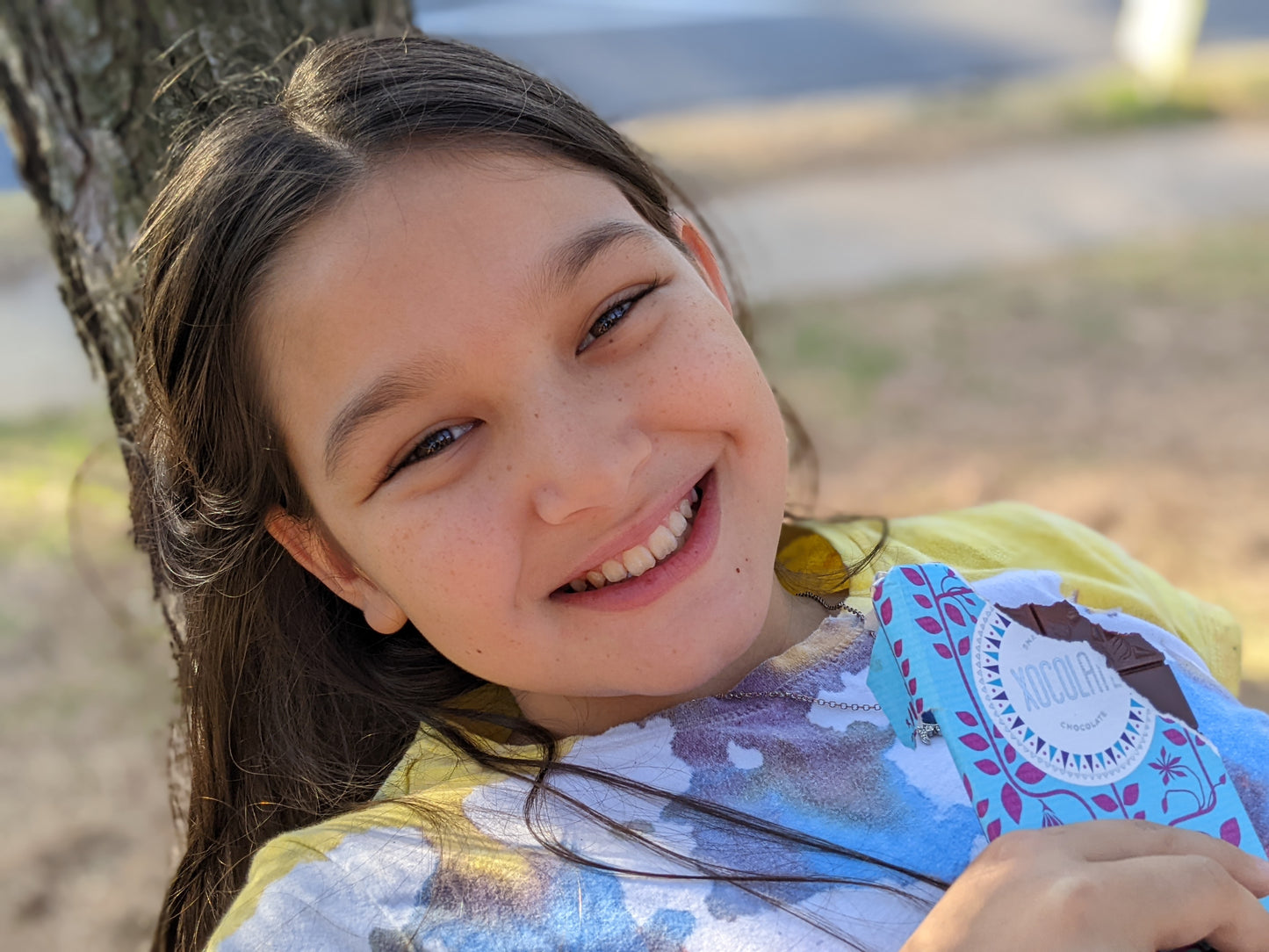
Our daughter is frequently snacking on chocolate up in her favorite tree, squirrel-like.
Recent articles published by the New York Times and Consumer Reports have raised consumer awareness around the presence of heavy metals like lead and cadmium in chocolate. While these reports were news to many, we became aware of the issue several years ago, when one of our California-based retail partners asked if we were compliant with California’s Proposition 65, legislation that requires businesses to include warning labels on products that contain above a certain threshold of carcinogenic chemicals to California consumers.
Back then, we had no idea if we were. But Matt and I did know that when we started Xocolatl, we were clear that we would only make chocolate we’d let our kids eat unlimited amounts of. While our own kids’ health and well-being has always held us accountable to the decisions we make about what goes into our chocolate, we knew we had to dig into Prop 65 to learn what more than personal ethics we needed to measure ourselves against.
Are We Living Up To Our Mission?

After a crash course in heavy metals and Prop 65, we sent our chocolate to a third party lab to check their levels of lead, cadmium, chromium, mercury and arsenic – 5 heavy metals that could possibly be found in chocolate. While waiting for the results, we spent an awful lot of time worrying about what we’d do if our chocolate contained unsafe levels of these metals.
We wondered what we could possibly say to our customers who’d become our friends over the years, supporting us at farmers markets and in our store, introducing Xocolatl to their friends and family because they think of us as makers of wholesome chocolate.
Since we knew that the heavy metals enter into chocolate through the soils in which the cacao is grown (the same being true for other agricultural crops grown in soil that contains these metals), we wondered if we’d be forced to part ways with any of the farmers with whom we’ve spent years building direct trade relationships and whose cacao we love to turn into chocolate bars.

Returning to visit the farmers whose cacao we purchase is the highlight of every trip to origin.
Fortunately, after several nail-biting days, we received back our test results and learned that the levels of metals in our chocolates are well below the Maximum Allowable Dose Levels (MADLs) that would require any warning labels (please see sidebar for more context on what MADLs mean).

We had the lab test all of our single origin chocolates, as well as our cacao husks (from which we make our Divine & Bewitching herbal cacao teas). You can download our full lab results from our most recent tests. From that raw lab data, we took the levels detected in each of our single origin chocolates and calculated the amounts that would then be present in each of our flavored bars. (Whenever our kids ask, “When am I ever going to use math when I grow up?”, I now have a really good example for them.) You can download the results for our full set of chocolate bars here.
I should mention that there are a lot of different opinions on how useful the limits set by Prop 65 are. How helpful is it to consumers to see a warning label even when the chemical has “no observable effect” on the human body at even 1,000 times the amount present in that item? How easy is it to gather that same information from every food an individual consumes each day? Without backgrounds in health or science ourselves, Matt and I decided that while we can’t provide answers to those questions, we could provide test results, a process by which we always test chocolate from new origins before we make it for our customers, and resources that may help our customers make their own informed decisions on how carefully they should review the levels of metals in their food.

While I’m sure very few people enjoy being handed a potential problem, we were grateful to have been alerted to an issue we didn’t even know existed by one of our California customers way back when. Researching this issue and testing our chocolate for heavy metals gave us the opportunity to understand our industry at an even deeper level than we would have ever imagined necessary.

We’re happy to report to you that we’re still allowing our children to eat as much of our chocolate as they could possibly want (and really, however you’re measuring it, it’s pretty hard to pound too much dark chocolate in any one day, each and every day), happy to report that our chocolate does not require Prop 65 warning labels, and happy to report that we will continue purchasing from the hardworking, expert farmers who grow the cacao we turn into chocolate.
And when we introduce new cacao origins, we promise you we will continue our third party testing to ensure we always know what is in our chocolate and we'll continue to update our results so you will, too.
In transparency + always good will,
Elaine + Matt
(written by humans and not AI!)






Thank you, Elaine and Matt, as said above, for the responsibility and values you lead with, and for educating us and providing such thorough transparency. No surprise, as your bars attest- you take your craft seriously, and I’m so grateful for all involved and the taste of each exquisite bar you make!
Thanks for always going a step above and beyond. Grateful that you can keep supporting your growers and that we get to enjoy all that yummy chocolate.
Proud of you every day!!